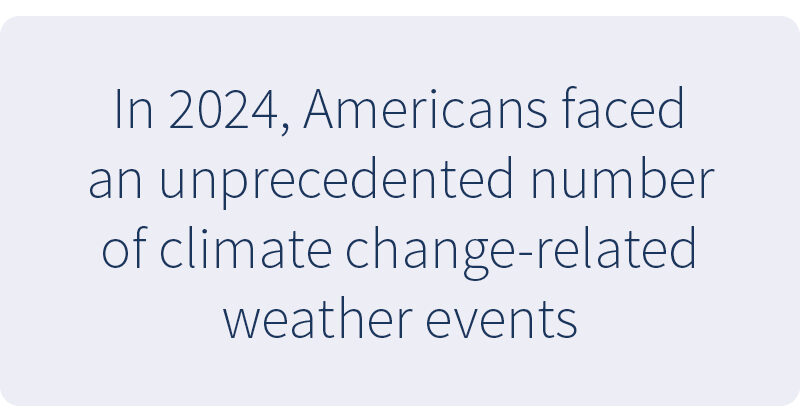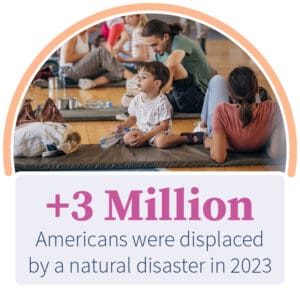 Filed Under: Social Determinants of Health
Filed Under: Social Determinants of HealthA Climate of Risk: The growing impact of weather events on maternal and infant health
Since our first maternal and infant trends report in 2021, we have covered topics from health policy to technology, employee benefit design, social drivers, and a host of other topics closely related to the maternal and infant health landscape. One of the trends we presented last year was the emergence of a new vision of risk. This definition encompassed factors such as mental health status, access to care, and climate change.
It’s that last factor, climate change, which in this moment, deserves reflection. The relevance of this trend became starkly evident in 2024 as Americans faced an unprecedented number of climate change-related weather events. Historic heat waves pressed down on the Southwest, flooding ravaged the Midwest, severe storms and wildfires tore across numerous states, and of course, vast destruction was wrought by Hurricane Beryl in the Midwest and Southeast—an event ProgenyHealth witnessed firsthand while working to assist those under our care management as they weathered the storm.

Maternal and Infant Health Impact
Perhaps it is not surprising that these events, previously seen as “once in a century” and “once in a generation,” seem to be more and more common. In 2022, the Union of Concerned Scientists issued a warning that “climate change is increasing the severity and consequences of extreme events.” And, Harvard T.H. Chan School of Public Health issued a sobering report on the need to address the impact of climate change on maternal and infant health.
While technological advancements have provided us with the opportunity to live in areas once thought inhospitable to life, the range of potential weather-related outcomes is increasing the risk associated with inhabiting, not just those places, but everywhere. Consider the following statistics:
- Heat waves have been connected to preterm births and air pollution to higher blood pressure in pregnant women. 2024 marked the United States’ fourth hottest summer on record.
- North America has seen a rapid increase in wildfires. A 2024 study published in the Journal of Hazardous Materials found that exposure to the particulate matter associated with wildfires in the month before birth had a dramatic impact on the odds of a newborn being admitted to the NICU.
- More than 3 million Americans were displaced by a natural disaster in 2023. A 2021 review published in the American Journal of Obstetrics & Gynecology, Maternal Fetal Medicine, found a connection between housing instability and preterm birth, low birthweight neonates, NICU admission, and delivery complications.

Climate Change is a Social Determinant of Health
In many cases, the aftermath of these disasters requires extensive cleanup efforts, causing long periods of displacement and lack of services for thousands of the most vulnerable. As we stated in last year’s report, climate change must now be considered a Social Determinant of Health (SDoH), or a social factor that can influence a person’s health status—one that’s no different in its impact than income, region, health insurance coverage, or level of education.
But amid this increasingly clear and present danger, healthcare innovation is stepping into the fray to thwart the effects that climate change will have on our health in the decades ahead. From medical products that may help us adapt to the new normal to health-focused climate surveillance systems that provide early warnings before disaster strikes, new thinking about how to continue living—and thriving—in this climate is already well underway.
Turning to 2025
While we acknowledge the ongoing and long-term impact of the trends we highlighted in 2024, it’s important to note that a new cohort of trends will present both opportunities and challenges in 2025. Our latest Trends Report covers 7 different trends, from the proliferation of genomic testing to a new emphasis on postpartum support.
Read the 2025 Trends Report




 Prev
Prev